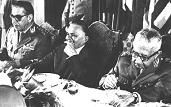#4
Mensagem
por VICTOR » Qua Nov 30, 2005 8:46 am
The aging carrier Kitty Hawk when it is retired from service in 2008, a senior defense official said Thursday.
The official, who spoke on condition of anonymity, told The Virginian-Pilot that an announcement of the shift will be made within a few weeks. It will allow the Pentagon to keep a force of six carriers in the Pacific, an area of growing concern to the Bush administration because of China’s aggressive efforts to upgrade its navy, but probably leave only five flattops in the Atlantic Fleet.
The move raises the possibility that the carrier force at Norfolk Naval Station could be cut from five to four, with a fifth Atlantic carrier assigned to Mayport Naval Station , near Jacksonville, Fla. Losing a carrier could drain about 3,000 jobs and hundreds of millions of dollars annually from the Hampton Roads economy.
“There are just a lot of things that aren’t final yet,” cautioned U.S. Rep. Thelma Drake, R-2nd District, who said Navy officials have not yet briefed lawmakers on their plans. She said she would be “extremely concerned” if the Navy tries to shrink its Norfolk-based carrier force, but it’s far from certain that will occur.
“Nothing will happen fast,” Drake said. Norfolk is easily the Navy’s largest hub for carriers, which along with being a source of civic pride are a major engine for the local economy. No other port has more than two flattops.
The loss of just one of the ships would drain about $225 million per year from the local economy, according to a preliminary estimate developed by the Hampton Roads Planning District Commission. David Gist, a commission economist, said the estimate is a rough calculation and could change depending on how the Navy executes the transfer. If the service sent the Washington’s air wing and other ships in its battle group along with the carrier, for example, the local economic damage could swell to $982 million annually, he said.
That scenario may be unlikely because other ships and an air wing already are in place in Japan with the Kitty Hawk. The George Washington would be the first nuclear-powered ship to be permanently stationed in Japan, the only nation ever attacked by nuclear weapons.
The Japanese government agreed last month to allow a nuclear ship to replace the oil-fired Kitty Hawk, but local opposition in the port city of Yokosuka, where the ship would be stationed, could sour the deal, Drake said.
Selecting a replacement for the Kitty Hawk has been a matter of some delicacy for the Navy and the Bush administration. The Norfolk-based
Harry S. Truman and the Nimitz, based in San Diego, were ruled out almost immediately because of President Truman’s decision to use nuclear weapons against Japan during World War II and Fleet Adm. Chester Nimitz’s role as a key leader of U.S. naval forces in the war.
The carrier George H.W. Bush, which will enter service as the Kitty Hawk retires, also was disqualified. The first President Bush flew Navy torpedo bombers in battles with the Japanese from 1942 to 1945. The transfer also could be politically delicate at home. While planning to send the George Washington to Japan, the Navy wants to retire the carrier John F. Kennedy, now based in Mayport, and reduce the overall carrier fleet to 11. The Navy hasn’t decided whether to replace the Kennedy in Mayport, but the senior defense official indicated that the Atlantic Fleet will retain five carriers with at least four of them in Norfolk.
A coalition of Virginia and Florida lawmakers blocked the Kennedy’s retirement earlier this year, forcing the Navy to keep the ship until at least the middle of 2006, and legislation to require a 12-carrier fleet is pending on Capitol Hill. The number of carriers and their placement around the world are major topics of the “Quadrennial Defense Review,” a Pentagon study of worldwide military threats and U.S. forces needed to meet them. The review is to be completed and submitted to Congress early next year, and defence officials have declined to speculate on what it might recommend.
Adm. Edmund Giambastiani, vice chairman of the Joint Chiefs of Staff, told reporters this week that the Defence Department remains committed to retiring the Kennedy. Other officials suggested privately that administration plans to cut Pentagon spending by $32 billion during the next five years will intensify pressure to mothball the ship.
The Navy estimates retiring the conventionally powered
Kennedy, now 38 years old and the most expensive-to-operate ship in the fleet, will save about $200 million per year. Adm. Michael G. Mullen, the
chief of naval operations, endorsed the cut last month, telling reporters that he’s satisfied the service can execute its missions with the 11 remaining flattops.
An aide to U.S. Sen. Bill Nelson, D-Fla., said Thursday that his boss still thinks a 12-carrier fleet is “the right thing to do for America ” but also intends to press for facility improvements that will allow Mayport to
accommodate a nuclear-powered carrier. That sets the stage for a struggle between Florida’s
congressional delegation, backed by Gov. Jeb Bush – the president’s brother and a potential Republican presidential candidate in 2008 or beyond – and a Virginia contingent led by U.S. Sen. John W. Warner,
chairman of the Senate Armed Services Committee, and Sen. George Allen, another GOP presidential aspirer .




![[082]](./images/smilies/082.gif)






